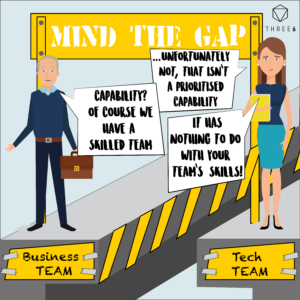Customer & Technology – Please Mind The Gap


There are times when you need to get technology involved whether that is with upgrading an existing system or creating a new experience using new technology.
I often start conversations saying “I am not a techy”, but do you know what, I am.
Let me be clear, I can’t program but I can understand what’s going on and I can understand how to take business needs and turn it into something that we can deliver through technology. This is a skill and a gap that we need to close between our teams to ensure that our transformations are embedded successfully.
In this blog, we will share some of our key tips to helping close the gap and most importantly help you achieve your goals faster.
Like many of our clients, my safe space was in the business and performance functions. We are all about the customer, we are all about making sure that we can deliver the outcomes as simply as possible while maintaining a great customer experience. We would always start with process improvement and do what we can without getting technology involved. Why? Because technology added time and complexity, not to mention the cost, and we knew that you can often get great results by using simple lean thinking.

However, there are times when you need to get technology involved whether that is with upgrading an existing system or creating a new experience using new technology. So here are 3 quick tips to help you mind the gap:
1. Get to understand what each other do?
One of the biggest problems that I see is different teams don’t understand what the other people are doing and their objectives. The business function needs to deliver great products that help increase revenue and the technology function wants to deliver the best tech solutions whilst also maintaining a simplified landscape. Often though these points are forgotten.
I remember many years ago, I knew what we were trying to achieve but I couldn’t understand that for some reason after having a conversation with someone from technology, I would leave the room more confused and wondering why it was going to take so much money and so much time to buy this vendor product that I needed?
The simple answer is I didn’t understand what technology needed and why they needed it. The technology landscape is complicated and especially in large organisations, adding another application isn’t just a matter of installing something on to your computer. How do you connect it into the network? where will it be stored? Can it be on the cloud? What security access does it require? Who will maintain and support it if it is to go wrong?
If someone had explained the different components then it would have been easier to communicate my needs and at the same time look at how I could support technology. At the end of the day is to ensure that we can run these business applications so they are current for their users and are cost-effective for the business, which is what we all need.
2. Communicate in simple language the outcomes that you are trying to achieve
Knowing now what you are both trying to achieve, the next step is to communicate in language that you both understand.
We all have a habit of speaking in acronyms. We assume that other people have the same knowledge that we do. But the truth is that they don’t. We think differently, we’ve had different experiences and training that often mean even if we understand the word we can have a different definition of it… like capability?
The next step in closing the gap is using words and language that everyone understands, don’t get lost in journey maps or application dependencies. Instead talk through each key moment what outcomes are needed, for the customer, the employee and therefore the process and technology that support it.
3. Learn to understand the impact of your decisions
Unfortunately, we live in a world where we need to prioritise. We don’t have endless resources to build the perfect experience. We instead need to understand what are the best possible outcomes for the environment that we are in.
We want the perfect experience, but maybe it’s not possible to have the process automated with real-time feeds.
So what are our options?
It would be great if we could tailor each screen for our employees specific to the products they work on, but maybe this would mean separate applications increasing our complexity and cost.
So what is the alternative that we can have?
Because the world will never be perfect we need to understand what the impact of the decisions that we make are both to the customer experience and our process or technology landscape. When we understand exactly what we are doing and why then it makes it is one step closer to successfully embedding our transformation.
So with the business focused on the customer, delivering new products, new outcomes and making sure that we can get it done faster and easier and our technology teams as problem solvers, finding the right solution that meets that need in the most efficient way. We need to find a common language, approach and understanding that will help close the gap and deliver excellent outcomes.
Nina Muhleisen
Founder & Principal Consultant
